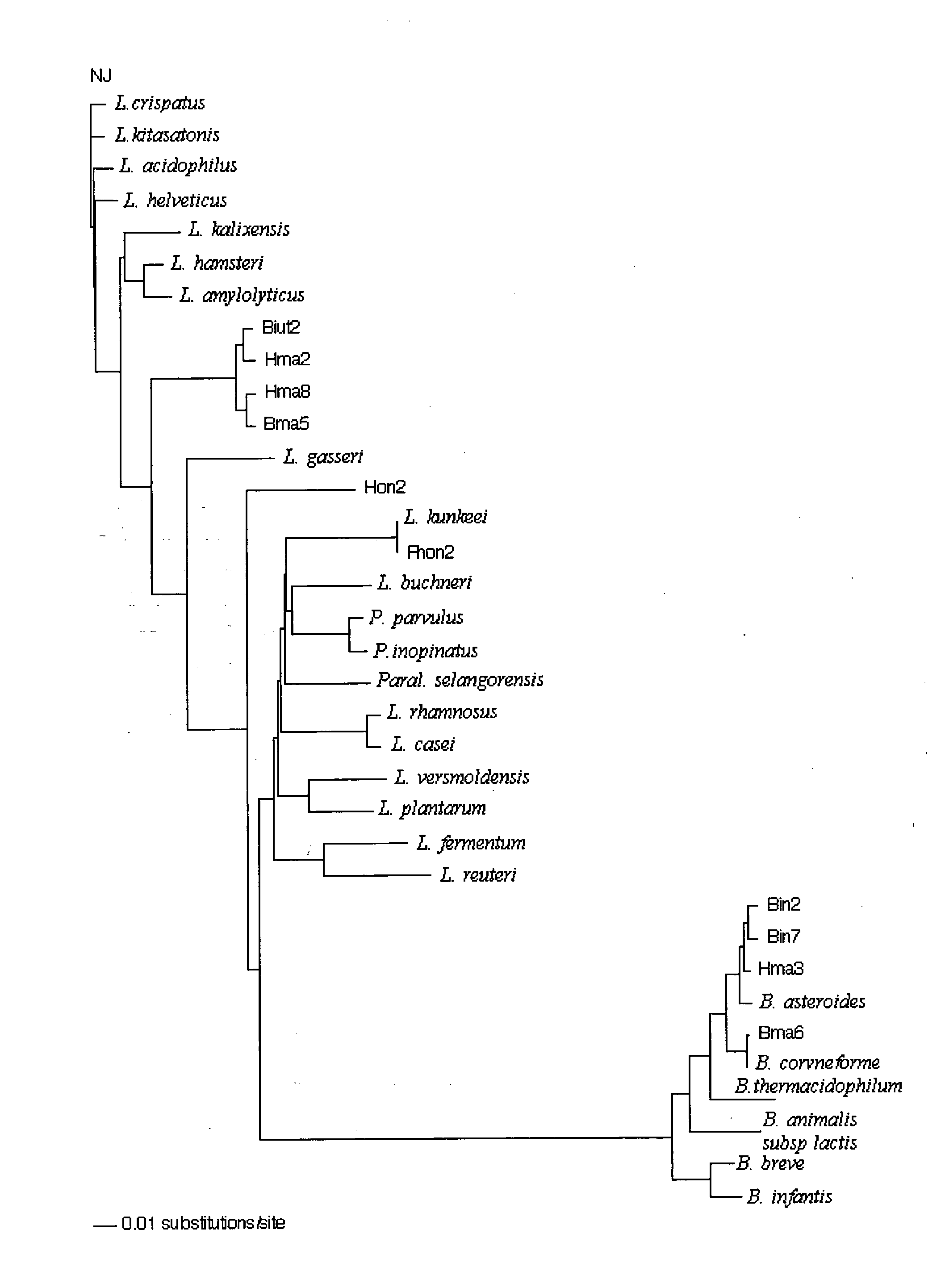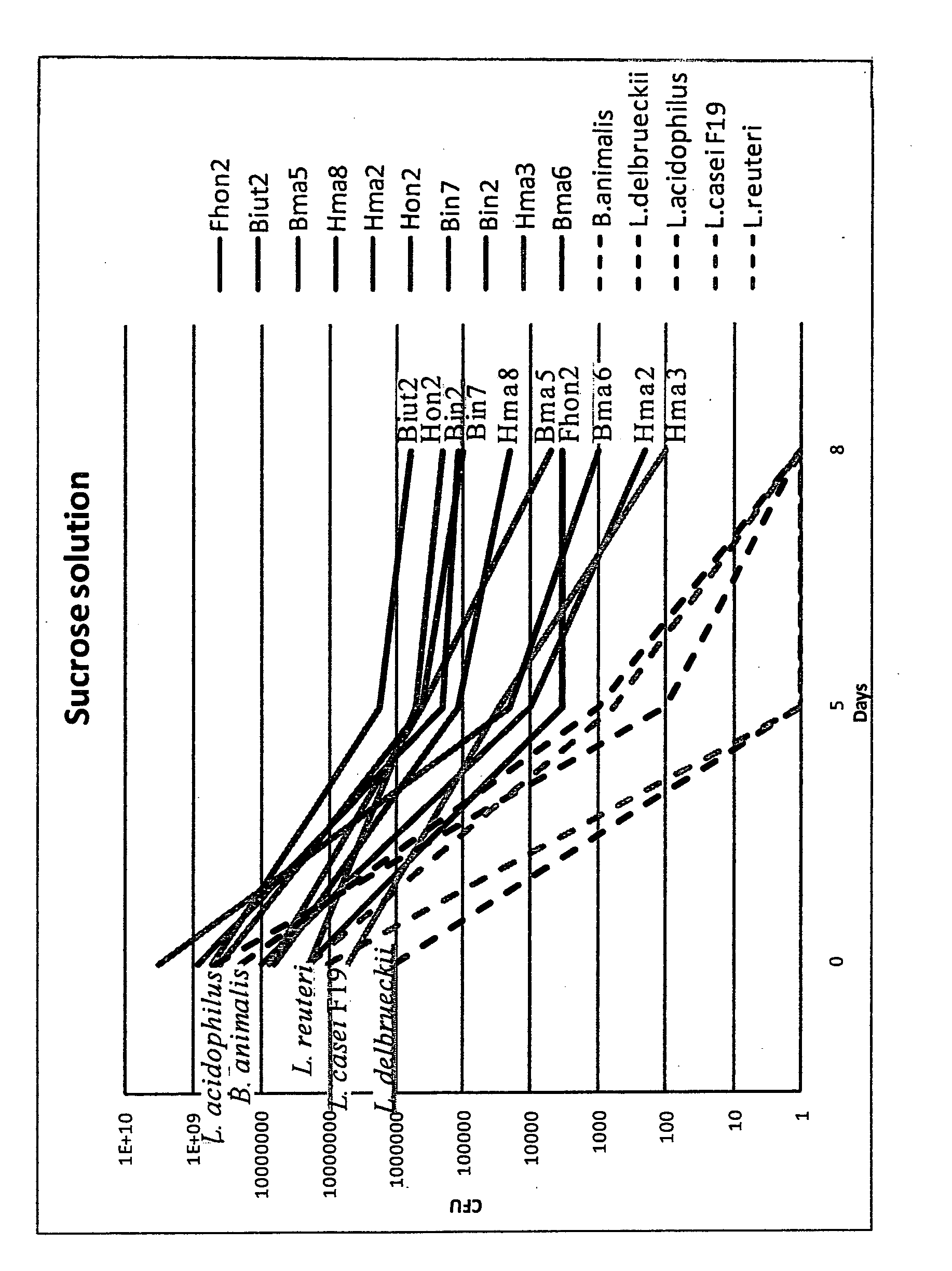Novel bacteria isolated from fresh honey or the honey producing tract of honey bees
a technology of fresh honey and bifidobacterium, which is applied in the field of new isolated lactobacillus and bifidobacterium strains, can solve the problems of antibiotic resistance and pathogenic bacteria becoming a big problem, and achieve the effect of efficient combating other organisms and unique health promotion properties
- Summary
- Abstract
- Description
- Claims
- Application Information
AI Technical Summary
Benefits of technology
Problems solved by technology
Method used
Image
Examples
example 1
Bee Hive Harvesting
[0102]A small bee hive with approximately 12.000 bees was transported to a field of wild raspberry flowers at the nature reserve Kullaberg situated at the North West of Sk{dot over (a)}ne, in the south of Sweden. No other flowers in the immediate area were flowering during that time and the bee hive was emptied of its honey when the experiment was initiated. In the second week samplings were performed on fresh raspberry flowers around the bee hive, outgoing and incoming worker bees and fresh raspberry flower honey from the bee comb. In addition to those samples, harvested raspberry honey was saved and analysed after two months of storage. The samples were cultivated in four different types of incubation media for all bacterial purpose and for the selection of LAB. The bacterial identity was revealed by the analysis of 16S rRNA genes using both the techniques of cloning and pure cultures.
example 2
Isolation of Bacteria from the Honey Bee
[0103]20 raspberry flowers, 10 incoming and 10 outgoing worker bees and 10 nurse bees were picked and sorted in different sterile 10 ml tubes containing 5 ml sterile physiological saline (0.9% w / v NaCl, 0.1% w / v Tween 80 and 0.1% w / v pepton). Moreover, 0.5 ml fresh honey, five honey bee larva (2-5 days old), five honey bee heads, five honey bee honey stomach and one honey bee hindgut, were collected separately in a 1.5 ml sterile micro tube containing 0.9 ml physiological saline. The analysis of the honey bee mouth and trunk was performed separating the head from the body with a sterile scalpel and tweezers. The heads were shaken in sterile dilution media followed by bacterial cultivation. The analysis of the honey bee stomach was carried out by excision of a with nectar full honey bee stomach after the oesophagus and before the proventriculus with sterile scalpel and tweezers which guaranteed that no parts of the intestine contaminated the sa...
example 3
Culturing of Bacteria from the Honey Stomach
[0105]From the samples described in example 2 a dilution series with sterile physiological saline was made and a volume of 0.1 ml was spread on different growth media. Growth and pure cultures were obtained on different media (see Table 2) from different dilutions with Tryptone Soy Broth agar (TSB) (Oxoid, Basingstoke, Hampshire, England), Tomato juice agar (TJ) (Oxoid), all purpose medium with Tween® (APT) (Merck, Darmstadt, Germany) and Rogosa agar (Merck). The media were produced according to the manufacture's instructions. The used combination of isolation media were shown to be of vital importance for the growth of the bacteria. All the isolates grew very well on Rogosa except Bma5, which had a restricted growth and Fhon2 that barely grew on Rogosa. On the contrary, Fhon2 (Lactobacillus kunkeei) grew very well on Tomato juice agar together with the strains belonging to the genus Bifidobacterium (Bin2, Bin7, Bma6 and Hma3). The other L...
PUM
| Property | Measurement | Unit |
|---|---|---|
| water content | aaaaa | aaaaa |
| temperature | aaaaa | aaaaa |
| temperature | aaaaa | aaaaa |
Abstract
Description
Claims
Application Information
 Login to View More
Login to View More - R&D
- Intellectual Property
- Life Sciences
- Materials
- Tech Scout
- Unparalleled Data Quality
- Higher Quality Content
- 60% Fewer Hallucinations
Browse by: Latest US Patents, China's latest patents, Technical Efficacy Thesaurus, Application Domain, Technology Topic, Popular Technical Reports.
© 2025 PatSnap. All rights reserved.Legal|Privacy policy|Modern Slavery Act Transparency Statement|Sitemap|About US| Contact US: help@patsnap.com



